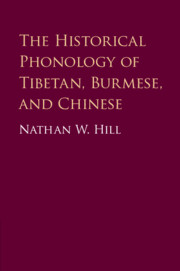Book contents
- The Historical Phonology of Tibetan, Burmese, and Chinese
- The Historical Phonology of Tibetan, Burmese, and Chinese
- Copyright page
- Dedication
- Epigraph
- Contents
- Figures
- Note on Abbreviations and Conventions
- Book part
- Introduction
- 1 Tibetan
- 2 Burmese
- 3 Chinese
- 4 Trans-Himalayan
- Appendix: Complete Lists of Examples
- References
- Index Verborum
- Index Rerum et Nomum
- Index Legum
2 - Burmese
Published online by Cambridge University Press: 22 July 2019
- The Historical Phonology of Tibetan, Burmese, and Chinese
- The Historical Phonology of Tibetan, Burmese, and Chinese
- Copyright page
- Dedication
- Epigraph
- Contents
- Figures
- Note on Abbreviations and Conventions
- Book part
- Introduction
- 1 Tibetan
- 2 Burmese
- 3 Chinese
- 4 Trans-Himalayan
- Appendix: Complete Lists of Examples
- References
- Index Verborum
- Index Rerum et Nomum
- Index Legum
Summary
§44. Prior to the appearance of Burmese the Pyu and Mon languages had already been spoken and written in what is now Burma for several centuries (Krech 2012: 120–3, Bauer 1990). Burmese emerged as the language spoken by the Burman population in Pagan at the time of the Pagan dynasty (1113–1287 ce). The Burmese-speaking population entered Burma from the north; this is clear from the distribution of the Burmish languages, namely that they are all in the north, and further the Burmese word toṅ ‘mountain’ means also ‘south’, which suggests that at one point the Burmans lived to the north of the mountains. The oldest document in Burmese is the Myazedi inscription of 1113 ce (cf. Nishida 1955, Yabu 2006). Essentially all documents in Old Burmese are stone inscriptions recording land grants to Bu ddhist establishments (cf. Frasch 1996: 1–16).
- Type
- Chapter
- Information
- Publisher: Cambridge University PressPrint publication year: 2019



